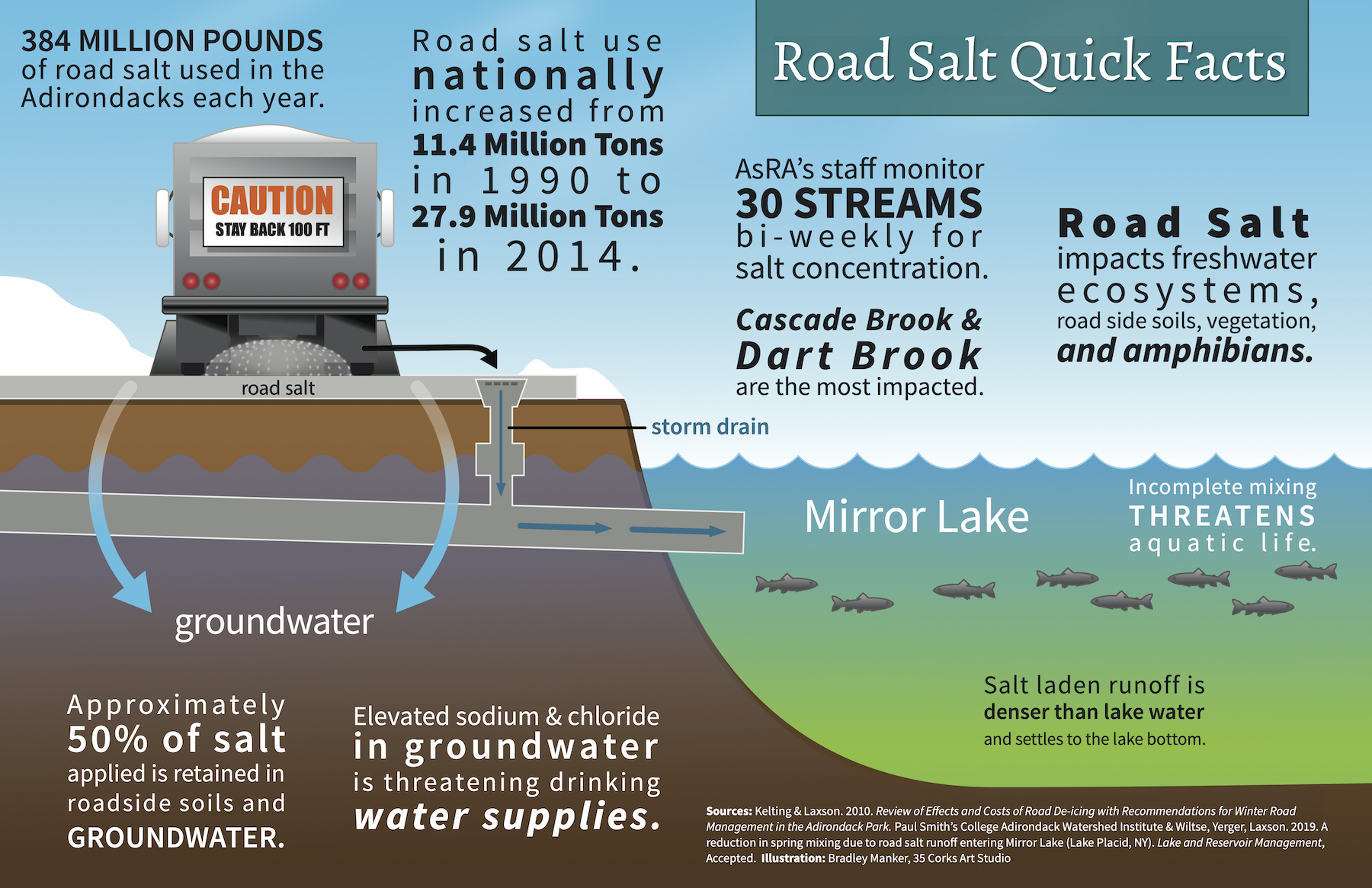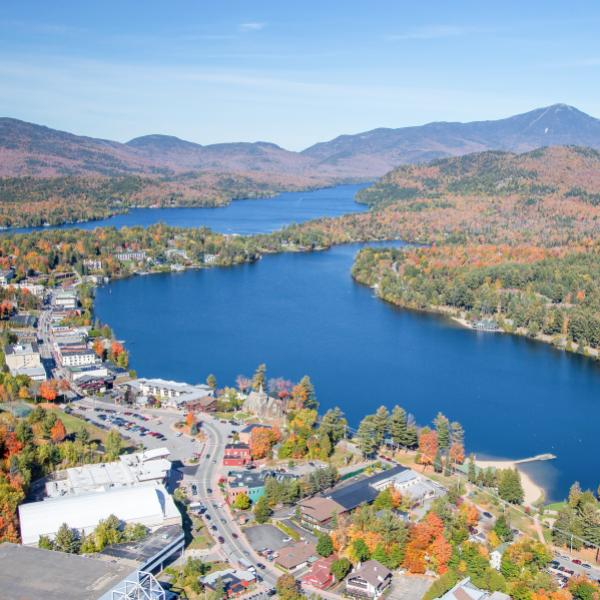For decades, road salt has been the clear choice for maintaining roads free of snow and ice during the winter. When used properly, it prevents the formation of hardpack on road surfaces and maintains safer road conditions during snowstorms. The widespread adoption and growing use of road salt hasn't come without costs. AAA estimates that road salt causes $3 billion in vehicle damage per year. And the USEPA estimates that road salt costs us around $20 billion annually in damage to vehicles and infrastructure.
The external costs of road salt extend beyond the obvious expenses associated with corrosion of vehicles and degradation of infrastructure. There are costs associated with loss of environmental services due to contamination of surface and groundwater. In a white paper published in 2012, the Adirondack Watershed Institute estimated that the Adirondack Park could be incurring as much as $544,000 per year in lost benefits from lakes and rivers. This estimate doesn't include costs associated with groundwater contamination.
The science on the environmental impacts of road salt is clear. When road salt moves off target surfaces, it enters our surface water and groundwater, and can too quickly contaminate these freshwater resources. A few streams in the Ausable River watershed exceed chronic toxicity thresholds for aquatic life for several weeks each year. Several of our watershed lakes have chloride concentrations 100-200 times higher than background levels. Data from biweekly monitoring of 30 stream sites in the watershed shows consistently high chloride concentrations in late summer through early fall. This is a period of time when our streams are at baseflow, fed primarily by groundwater. Elevated chloride concentrations at this time of year suggest groundwater contamination. Recent work by the Adirondack Watershed Institute has confirmed widespread groundwater contamination in the Adirondack Park, primarily downslope of state roads. Studies elsewhere in New York have found similar results. Some wells are exceeding EPA drinking water guidance values for both sodium and chloride, potentially turning road salt into a human health issue. How do we respond in a way that ensures safe winter travel while protecting freshwater?

Ausable Sustainable Salt Initiative
In response to the growing body of scientific evidence that indicates a reduction in the use of road salt is necessary to protect human health and the environment, AsRA launched the Salt Use Reduction Initative (SURI) last year. SURI is a collaborative partnership to leverage science, technology, best practices, and community engagement to reduce road salt use in the Ausable River watershed. The initiative is based on four pillars; science, technology, best practices, and community.
Meticulous field science identifies the problem and its magnitude. Science and continuous monitoring, to understand the relative success of changes in road salt management implemented in a reduction program, underpin the SURI model. Many of the impacts of road salt on the environment were poorly understood for decades due to inadequate research and limited monitoring. The disruption of the turnover of Mirror Lake is a prime example. This was first discovered by AsRA's staff in 2015 and confirmed through rigorous scientific research in 2017. A review of the limited historical data available for the lake suggests salt impacts may have been occurring for at least a decade, if not longer. Had we known earlier, we could have acted sooner to reverse course. Nevertheless, the problem is now well defined, and solutions are available. Rigorous ongoing monitoring is critical to evaluating the effectiveness of investments in best management practices and to benchmarking our progress toward a clearly defined goal. Monitoring also allows us to detect new environmental threats early and respond rapidly.
Advances in technology, both for environmental monitoring and salt application, define the second pillar of effective salt use reduction. Automated vehicle location systems help highway departments track plow operations, including salt use. These data are used by municipalities across the country to fine tune their salt application. In the Lake George watershed, some municipalities have achieved a 30 to 50% decline in salt use utilizing this technology. There are other advances in technology that can and should be leveraged in our efforts to reduce road salt. New plow technology, such as Live Edge plows, can more effectively remove snow and ice from road surfaces, reducing the need for sand and salt. Improved weather information systems can help local highway departments plan for upcoming storms, as well as tailor application rates to current weather conditions. And advances in environmental monitoring equipment can provide us better high quality data to ensure water quality protection goals are being met.
Adopting best practices, the third pillar of SURI, is central to the long-term success in reducing salt use. Application rates, whether to a road or sidewalk, should vary based on air temperature, pavement temperature, humidity, and storm progression. Antiicing before storms can substantially reduce the need to use salt to "burn off" hardpack and accumulation. In order for salt to start melting snow and ice it first needs to form a brine. Applying salt as a brine can speed up melting and allow for targeted application.
Last but far from least, community engagement and support are needed to create a more sustainable future. Providing the public with information about the detrimental effects of road salt and the details about the options available, is essential to building community-wide understanding and support for municipal action. Community engagement is also essential for identifying individual beneficial practices. Sidewalk and driveway maintenance can make a big difference in a small watershed like Mirror Lake. The driving public also plays an important part in these efforts. Using snow tires, regular vehicle maintenance, and planning for winter conditions are all steps each of us can take to stay safe on our roads. Community action and support is essential to finding practical, lasting solutions.
A Problem We Created, One We Can Solve
Road salt pollution is a problem we created in our own backyard; it is up to us to address it. Unlike many other environmental problems, we aren't dependent on the federal government or international partners to implement solutions. And we are already headed in the right direction. The Town of North Elba has made investments in Live Edge plows, the Village of Lake Placid has made stormwater improvements around Mirror Lake, NYS DOT initiated a pilot program along Route 86 between Lake Placid and Wilmington, and we continue to work with our partners to monitor, share best practices, and engage the community. Together we'll find solutions for Mirror Lake; solutions that will be a model for helping other communities.
While progress is being made, there is much more that needs to be done. The magnitude of the road salt problem needs to be matched with significant investments in order to achieve tangible improvements. The focus on Mirror Lake is in part due to the severity of the problem but, because of its manageable size, the existence of some baseline data, and the engagement of the Lake Placid community, it can also serve as a powerful model for other communities grappling with salt impacts.
Your contribution will help advance the Salt Use Reduction Initiative and protect our clean water.
Our work on Mirror Lake has shown that no one entity is responsible for the condition of the lake – it's all of us. This presents a huge challenge for implementing systemic and sustainable change. We don't just need the state, town, and village to make change, we need every home and business owner, maintenance worker, and caretaker involved.
SURI provides the support needed for our communities to make lasting change. It ensures that the science – which led to the discovery of road salt impacts on our environment and groundwater – continues. We look forward to telling a story of redemption for Mirror Lake in several years. We can do this. Just as importantly, we can show others how to find a more sustainable approach to winter road, parking lot, and sidewalk management.
Sign-up for our e-newsletter to get weekly updates on the latest stories from the Ausable River Association.




